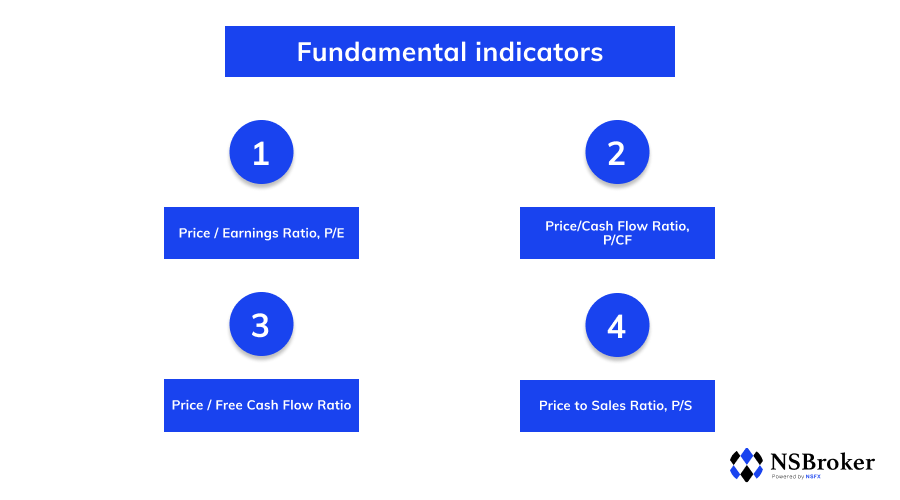Reading Financial Indicators When Buying Stocks for Beginners

If you are interested in trading in financial markets, particularly in the stock market, you must know how to read the financial indices of companies. Every successful trader knows how to extract information from financial reports for market analysis. In case you are just a beginner, we would recommend you to study data and reports of companies for reporting periods before entering the deal. Usually, companies release their financial reports once a quarter half a year, and the entire year. If you plan on making money by trading on the day-to-day price fluctuations, you may disregard this information, as it is much more useful while investing in for the long term. We have prepared a list of financial indicators that might help you clarify the situation, and decide either to buy specific stocks or not.
Fundamental indicators
- Price / Earnings Ratio, P/E
The Price / Net Income multiplier (Price / Net Income or Price / Earnings Ratio, P/E) is the most common and frequently used indicator when evaluating a company. It links the price of a share to the company's earnings and shows how much investors are paying for $ 1 in profit and how soon their investment will pay off.
P/E is calculated by dividing market capitalization by net income or dividing the price of one share (P) by earnings per share (Earnings Per Share, EPS):
P/E = Market Share Price (P) / Earnings Per Share (EPS)
To calculate the P / E ratio, not just any earnings are used, but earnings per share for 12 months, and not only past but also future. In this regard, there are two types of EPS and, accordingly, P / E:
Trailing P/E - based on past actual earnings.
Forward P/E, Projected P/E - based on analysts' expected profit forecasts.
Comparing the moving and forward P/E gives the investor an idea of the company's prospects. The decrease in the latter indicates that the market expects growth from the company (however, there are no guarantees that these forecasts will come true). In turn, the inverse of the P/E ratio is often used as an indicator of profitability. So, with P/E = 15, the expected level is 6% (1/15).
- Price/Cash Flow Ratio, P/CF
The Price / Cash Flow Ratio (P / CF) compares the market value of a company with the value of its cash flow from operations and allows us to judge the company's ability to generate cash flow from its core (operating) activities, that is, the one for which it was created. It is calculated as:
P/CF = Market value of the company / Amount of cash flow from operations
When analyzing the P/CF value, the investor should remember that the amount of cash flow is always different from the net profit. Because the net profit is the figure in the report, the cash flow is real money. In this connection, the main advantage of the cash flow indicator is that, unlike net profit, its value is more difficult to manipulate.
- Price / Free Cash Flow Ratio
However, taking into account the fact that the value of CF from operating activities does not take into account the volume of capital expenditures required for business development, the investor should use the Free Cash Flow (FCF) indicator in the calculations. This indicator makes it possible to understand how much funds remain at the disposal of the company and can be used to pay dividends. It is calculated (simplified) according to the cash flow statement as follows:
Free Cash Flow = Operating Cash Flow - Capital Expenditure
Free Cash Flow = Cash Flows From Operating Activities - Capital Expenditures
A P/FCF value < 20 is considered normal. P/FCF <15 indicates healthy business and that the company has money left over to pay dividends or buy back shares.
- Price to Sales Ratio, P/S
The Price / Sales Ratio (P / S) measures a company by sales volume and gives an idea of how much an investor is paying for $ 1 of its revenue. This indicator is calculated as:
P/S = Market value of the company / Sales volume
P/S = Market Capitalization / Sales (Revenue)
The P/S ratio is good for evaluating large-cap companies and worse for service companies, for example, banks, insurance companies, since they do not have sales in the literal sense of the word. The value of the P/S index <2 can be considered the norm. The lower the P/S, the better, and the less the investor pays for every dollar the company receives from sales. A P/S value <1 indicates that it is possible to buy that dollar of sales at a discount.
So, if the company's sales are $ 1 billion, and its market value is estimated at $ 900 million, then P/S = 0.9. And by purchasing shares of such a company, the investor buys $ 1 of sales for $ 0.9. Provided that the other indicators of the company are normal, this can be considered a bargain. However, the investor should remember that past earnings do not guarantee future returns. A company with a low P/S must have a strategy to grow sales and increase profits.

Turnover indicators
- Receivables turnover ratio
Shows the average time required for debt collection. The larger this number, the faster the receivables turn into cash, and therefore the liquidity of the company's working capital increases. A low ratio may indicate difficulties in collecting funds from debtor accounts.
- Inventory turnover ratio
Reflects the rate at which stocks are sold. On the one hand, the higher this indicator, the more efficiently the company's resources are used. On the other hand, a high inventory turnover increases the requirements for the stability of the supply of materials and goods and can affect the stability of the business.
- Total assets turnover ratio
It characterizes the efficiency of the company using all available resources, regardless of the sources of their attraction. This coefficient shows how many times a full cycle of production and circulation is performed per year. Its values vary greatly from industry to industry.
- Fixed assets turnover ratio
The indicator is also known as “return on assets”. This coefficient characterizes the efficiency of the enterprise's use of fixed assets at its disposal. The higher the value of the ratio, the more efficiently the company uses fixed assets. A low level of capital productivity indicates insufficient sales or too high a level of capital investment. However, the values of this coefficient are very different from each other in different industries. Also, the value of this ratio strongly depends on the methods of depreciation and the practice of assessing the value of assets. Thus, a situation may arise that the turnover rate of fixed assets will be higher in an enterprise that has worn-out fixed assets.
- Working capital turnover ratio
Shows how efficiently the company uses investments in working capital and how it affects sales. The higher the value of this coefficient, the more efficiently the company uses its net working capital.
- Net operating cycle
Indicators RT and IT in this formula are used in the calculation option in days. Reflects the period in days for which the working capital is funded. The longer this period, the greater the liquidity risks.
Financial soundness indicators
- Financial leverage ratio
Characterizes the firm's dependence on external loans. The higher the value of the coefficient, the more loans the company has, the higher the risk of insolvency. The high value of the coefficient also reflects the potential danger of the enterprise having a shortage of funds. The interpretation of this indicator depends on many factors: the average level of this ratio in the industry, the company's access to additional debt sources of financing, and the specifics of current production activities. Typically, values greater than 1 may indicate potential difficulties in securing payments, since at this level the debt can no longer be fully repaid from the share capital.
- Equity-to-debt ratio
It characterizes the stability of the company in relation to its debt obligations. The opposite of financial leverage.
- Interest coverage ratio
Shows how large a reserve of income the company has to ensure payments related to the cost of borrowed loans. This indicator should be more than 1, but specific recommendations depend on many circumstances.
- Overall debt coverage ratio
The indicator reflects the margin with which the planned payments to the bank are provided, connected both with interest and with the repayment of the principal debt. The higher this indicator, the more the bank is confident that payments will be made on time. As a rule, depending on the circumstances, the minimum allowable KPI value is set between 1 and 1.5.










